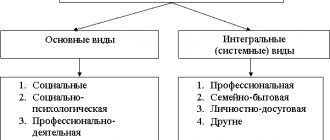Victimization is a concept that in some psychological modalities is interpreted as the process of becoming a victim. According to one of the founders of the doctrine of positivist victimology, B. Mendelssohn, the concept of “victim” is the opposite of the concept of “criminal”.
The very term “victim” and the theory that a person, unconsciously or consciously, by his behavior provokes a criminal to commit violent acts, causes a lot of controversy among psychologists.
What is victimization behavior
The concept of “victim behavior” is often used in criminal psychology. Specialists in this area consider the victim’s behavior from two points of view.
According to the first, a person who has suffered from violent acts provokes the rapist to commit a crime - attacks, threatens, beats, robs or commits other dangerous actions. According to the second version, the victim does not consciously provoke, but certain actions on her part make the rapist want to demonstrate aggression
.
As an illustration, we can consider the actions of a doctor who was unable to help a patient (due to an error or other reasons); this caused the patient or his relatives to want to take revenge on the specialist. If we consider this situation from the first point of view, then the patient plays the role of the victim. He chose a specialist who played the role of the rapist. The patient-victim at the treatment stage sees in the doctor a strong person who can be trusted and admires him. The victim herself, who finds herself in a similar situation, is characterized by low self-esteem, shy and timid. Often such a person shifts the blame for his mistakes and failures onto those around him, “fate”.
Adhering to the second interpretation, we consider the situation as follows. The specialist takes the position of a rapist - he conflicts, uses physical or other types of violence. When he meets a stronger opponent in the person of a relative of the patient, he himself enters into the role of the victim.
It also happens that a physically and psychologically very strong person chooses to play the role of a victim. He is forced to make such a choice by circumstances in which it is necessary to protect himself or loved ones from injustice, to defend his own principles. Such behavior is not considered pathological and is justified in a psychological sense.
Notes
- ↑Dodonov V.N., Ermakov V.D., Krylova M.A. and others. Large legal dictionary. M.: Infra, 2001 [1]
- ↑Luneev V.V. VICTIMOLOGY // Great Russian Encyclopedia. Volume 5. Moscow, 2006, p. 307 [2]
- ↑General psychology: words. / ed. A. V. Petrovsky. — M.: Per Se; St. Petersburg : Rech, 2005. - 250 pp.; — (Psychological lexicon: encyclical words in 6 volumes). [3]
- ↑Zhmurov, V. A. Great encyclopedia of psychiatry / V. A. Zhmurov. — 2nd ed. - M.: Dzhan-gar, 2012. - 864 p. [4]
- ↑ABC of a social psychologist-practitioner: reference and encyclopedic publication / M. Yu. Kondratyev, V. A. Ilyin. - Moscow: Per Se, 2007. - 463 p. [5]
- ↑James Dignan. Understanding Victims and Restorative Justice. NY: Open University Press, McGraw-Hill Education, 2005. P. 23
- ↑Post-crime victimization or secondary victimization (undefined)
.
Comprehensive Criminal Justice Terminology
. Prentice Hall. Archived March 10, 2013. - ↑ Campbell R., Raja S.
Secondary victimization of rape victims: insights from mental health professionals who treat survivors of violence (English) // Violence Vict: journal. - 1999. - Vol. 14, no. 3. - P. 261-275. - PMID 10606433. - ↑ Doerner, William.
Victimology (undefined). - Burlington, MA: Elseiver, Inc., 2012. - ISBN 978-1-4377-3486-7. - ↑Simon, George K (1996). In Sheep's Clothes: Understanding and Dealing with Manipulative People. ISBN 978-0-9651696-0-8.
- ↑Evans, Katie & Sullivan, J. Michael Dual Diagnosis: Counseling the Mentally Ill Substance Abuser (1990)
- ↑Petruska Clarkson, Transactional Analysis in Psychotherapy
(London 1997) p. 217 - ↑Eric Berne, Games People Play
(Penguin 1964) p. 92 and p. 141-2
Basic principles of victimization
The tendency to victimize is formed in childhood and consolidated in adolescence. One of the most important factors in the formation of victimization in children is the situation of physical and emotional violence in the family. A significant role is also played by the destructive influence on the psyche of adolescents from significant adults (relatives, teachers), and peers.
Under the influence of these factors, certain personal characteristics appear:
- increased anxiety, uncertainty and low self-esteem;
- emotional instability;
- the tendency to ignore one's own interests in favor of others.
Often, a “victim” with low self-esteem strives to prove his strength, rightness, and test his strength. This results in risky behavior (most often in adolescents).
In some cases, victimization is a concomitant of mental disorders. Problems of social adaptation of a pathological nature can result in a tendency to masochism and sadism, exhibitionism, and nymphomania. Similar manifestations of mental abnormalities can occur among victims of crimes (sometimes repeated with the same victim).
A person can also fall into the position of a victim if he:
- is in a subordinate position, he fulfills the demands of the aggressor, but very slowly, which “angers” the attacker even more;
- behaves provocatively or in his usual way, but the abuser views his behavior as offensive.
The fact that the aggressor in both these cases perceives the actions of the “victim” as offensive and unacceptable is solely his subjective opinion of the attacker. It is connected with the peculiarities of his perception and thinking.
Literature
Dissertations
- Adigyuzelov K. A.
Problems of victimization of the population (based on materials from the Republic of Dagestan): Author's abstract. diss... cand. legal Sci. - Makhachkala, 2002. - 28 p. - Konovalov V.P.
Victimization from crime and its statistical expression: Abstract of thesis. diss... cand. legal Sciences / All-Union Scientific Research Institute of the Ministry of Internal Affairs of the USSR. - M., 1979. - 22 p. - Leletova M.V.
Prevention of criminal victimization of small businesses: Author's abstract. diss... cand. legal Sci. - Nizhny Novgorod, 2006. - 35 p.
Books
- Polubinsky, V.I.
Criminal victimology: Monograph. — 2nd ed. - M.: All-Russian Research Institute of the Ministry of Internal Affairs of Russia, 2008. - 53 p.
Articles
- Arutyunova, A. B.
Criminological problems of the process of victimization of minors // Investigator. - 2002. - No. 6 (50). — pp. 27-29. - Batagov S. R.
Main trends in the development of economic crime and victimization from it at the present stage // Law and Politics. - 2008. - No. 6. - P. 1459-1462. - Vandyshev V.
V. Situations of victimization of citizens from theft of personal property in the sphere of everyday life // Fight against crime and problems of neutralizing criminogenic factors in the sphere of family and everyday life. - L.: Leningrad State University Publishing House, 1985. - P. 54-63. - Vishnevetsky K.V.
Urbanization and its influence on the processes of victimization of the population // Legal world. - 2006. - No. 3. - P. 65-70. - Vishnevetsky K.V.
Terrorism as a factor of mass victimization of the population // Bulletin of the Moscow University of the Ministry of Internal Affairs of Russia. - 2006. - No. 4. - P. 85-90. - Research in Germany on sexual victimization of women. // Fighting crime abroad. - 2004 - No. 8. - P. 20-27 (Published in: Kriminalistik. - 2002. - No. 4. - S. 241-245.
- Leletova M.V.
Problems of improving the system for preventing victimization of small businesses // Investigator. - 2007. - No. 3. - P. 38-43. - Leletova M.V.
Prevention of victimization // Investigator. - 2007. - No. 4. - P. 42-45. - Nevsky N. N., Nevsky A. N.
The influence of the victimogenic situation on victimization // Bulletin of the Vladimir Law Institute. - 2008. - No. 1. - P. 184-186. - Fenveshi Ch.
Violence in criminal proceedings: Subjects of secondary victimization // Journal of Russian Law. - 2003. - No. 2. - P. 136-142. - Fortova L.K.
Victimization of minors as a legal phenomenon // Law and State. - 2007. - No. 8. - P. 136-140.
How does victimization manifest itself?
Victim behavior , according to some experts, is reflected in the fact that a person often finds himself in situations where he finds himself in the position of the victim. In criminal psychology, victimization is considered as the ability to “attract” and attract the attention of antisocial individuals - rapists, maniacs.
According to victimization theory, the victim behaves in a certain way. His behavior arouses increased interest and awakens the desire to show aggression in the criminal.
Victim behavior from a psychological point of view
According to supporters of the victimization theory, it is especially often demonstrated by adolescents who:
- very ambitious;
- tend to defend their point of view;
- maximalistic;
- have insufficient life experience.
All of these factors cause teenagers to often find themselves in unpleasant, and often dangerous, situations. It’s not the result they hoped to get that forces them to “go for a second round” and achieve their goal. This again turns into trouble.
Some people tend to conflict even when there are no objective reasons for a clash. But it is known that those who offend their peers direct aggression towards children and demonstrate special behavior. They do not enter into conflicts even if their personal interests are affected; they try to avoid confrontation and hide from troubles.
“Victims” are vulnerable, naive, and physically weaker than their offenders. The appearance of those who more often than others fall into the “victim” position also attracts attention. Teenagers often have an absent-minded look, a rustic expression on their faces, stoop, their gait is uncertain, mincing.
Here we cannot help but emphasize that legal experts and the vast majority of psychologists believe that such “signs of a victim” in no way justify the criminal and do not reduce the degree of his guilt for the violence committed.
Two types of victimization behavior
People who tend to exhibit victimized behavior can take the place not only of a potential victim, but also of a rapist. Therefore, there are 2 very different types of behavior.
Compromising or conforming - people take on the role of a victim, expect violent actions against them, deception, and insults. They show timidity, easily submit to the will of others, and often not only justify the behavior of their rapist, but also consider it correct. The reason for such “worship” of the aggressor is that the victim sees in him a stronger personality who is capable of committing actions that she herself does not dare to do.
People with a conformist position have low self-esteem; they are confident in their insignificance and inability to decide or be responsible for anything. They shift the blame for their failures onto external circumstances or other people, like to complain, and do not hide their position: “What about me? I'm just a victim."
Demonstrative or emotionally unstable behavior is typical for people who themselves show aggression and provoke others. The form of provocation can be open or implicit. This behavior manifests itself in bullying of the weaker and psychological violence.
Watch the video
—>
Victimization is the probability of an individual being, under certain objective conditions, in the role of a victim.
Individual victimization is the properties (of a social, biophysical or psychological nature) of an individual that, in a certain life situation, contribute to the creation of conditions for committing a crime with causing him certain harm.
Species victimization is the predisposition of individuals to become, due to a number of circumstances, victims of certain types of crimes (for example, robbery, rape, etc.).
Group victimization is common for certain categories of people who have similar social, demographic, psychological, biophysical and other qualities of “increased ability” to become victims of crime (collectors, watchmen, taxi drivers, etc.).
Mass victimization is an objectively existing possibility for a certain part of people, due to their subjective qualities, to suffer physical, moral and material damage from crimes.
When determining “victimization”, the decisive and only criterion is the characteristics of the victim. However, an individual may be a victim not simply and purely due to his “personal” characteristics, but due to their combination or relationship with other factors.
Two other main types: general (depending on age, gender, occupation, social status, etc.) and special (depending on mental instability, characteristics of the will of alcohol intoxication, characteristics of the will and emotional instability, etc.). As some analysis shows, when these two types of victimization are layered, the degree of victimization increases significantly.
Research shows that women are characterized by increased victimization - in cases of committing crimes such as fraud, torture; men – in cases of murder and grievous bodily harm. This circumstance is apparently related to the nature of the social roles performed by men and women in the formal and informal spheres, and to their way of life in everyday life.
The choice of a crime victim by a criminal is an important, but not the only factor that determines victimization. Another circumstance is also significant – the type of behavior of the victim. So, before committing a crime, behavior can be:
1. Provoking, when a person, through his actions, creates a criminogenic situation.
2. Active, when a person does not create a criminogenic situation, but through his actions significantly contributes to its occurrence.
3. Passive, when the role of the victim in creating a criminogenic situation is insignificant or absent altogether, i.e. a person becomes a victim, as a rule, without connection with his behavior before the crime was committed.
The behavior of the victim after the commission of the crime deserves special attention. In practice, situations often occur when victims of a crime do not report this to the relevant authorities. From a criminological point of view, such behavior is one of the conditions conducive to the continuation of criminal behavior. Therefore, it is important to establish the reasons for the victims’ refusal to report what happened. Analysis of empirical material shows that such behavior of victims is explained by: friendly relations with the criminal, reluctance to deal with formal criminal procedural relations, reluctance to “compromise oneself” before the laws, friends and illnesses, fear of disclosing the fact of the assault, reluctance to destroy the family, the desire to “ deal" with the perpetrator, disbelief in the ability of law enforcement agencies to solve the crime, the pressure of related feelings, fear of the offender, a kind of self-sacrifice, taking the blame for what happened upon oneself, misconception regarding the nature of the guilty actions committed, etc. Provide their analysis for each type of crime and classification Accordingly, developing a system of victimological forecasting and prevention is a great task for the science of criminology.
Criminological victimization is the increased ability of a person, due to a number of subjective and objective circumstances, to become an object of criminal attacks.
Quantitative signs of victimization:
- Volume – the number of crimes expressed in absolute numbers that resulted in harm to individuals and legal entities; the number of victims of these crimes in a certain territory for a certain period;
- Level – the total number of recorded crimes that resulted in harm to individuals and legal entities; the number of victims of these crimes, as well as cases of harm caused by crimes in a certain territory for a certain period.
The essence of victimization is determined by the number of victims of the most dangerous crimes in the structure of victimization, as well as by the characteristics of the personalities of those against whom crimes are committed.
Types of victimization
Victimization is a large complex of features that are considered as the cause of aggression and illegal actions. Researchers have identified several types of victimization.
Behavioral - manifests itself in the position “I am guilty” and “I am innocent.” A person who takes the position of an innocent person often provokes aggression towards himself and deliberately chooses dangerous situations. Being in the position of the innocent, he falls into it by accident, he does not provoke the aggressor in any way.
Based on the number of victims, mass and individual victimization are distinguished. With mass victimization, a large group of people (often of a certain nationality, with physical characteristics) suffers. In the case of individual victimization, there is only one victim.
Factors that give rise to a tendency towards victimization
It is believed that the victim’s victim behavior manifests itself against the background of mental disorders and personality traits. But there are other reasons that make a person behave like a victim.
Social factors
Stable self-esteem, the ability to defend one’s interests and boundaries are formed in the process of upbringing in a family. A person who grew up in a calm environment, felt complete acceptance and love from his parents, respect from adults for himself and for each other, even on a subconscious level, does not wish harm to himself. He has a well-developed instinct of self-preservation, which prevents victimization from appearing.
In order for the innate survival program inherent in each individual to fail, and for a person to become a victim, he must be influenced by very serious factors. They may be:
- peculiarities of upbringing in the family - frequent conflicts, drunkenness of parents or one of them, drug addiction, antisocial lifestyle, physical cruelty towards the child, psychological violence;
- the child’s lack of feeling that his parents love him, care for him, and treat him with warmth;
- excessive care from parents. Attempts to protect the child from any difficulties of life and external influences do not allow the personality to develop normally. As a result, a person grows up who does not know how to distinguish between good and bad, and to resist pressure and danger. A person who grew up in conditions of hyperprotection is infantile, does not know how to plan the future and foresee the result of his actions, and does not know the laws of society well;
- conflicts among peers (most often in adolescence);
- negative emotional experiences (participation in or observation of scenes of violence) in childhood;
- a feeling of insufficient attractiveness, inferiority, which appeared due to the reaction of others to personal characteristics.
The listed factors are associated with the aggressive, toxic environment in which a person grows. Such conditions form a subjective, deformed idea of oneself, one’s own place in society, and the significance of life.
Phenomenological factors
The unfavorable environment in which a child is raised often creates the basis for his victimization. He becomes a person unable to stand up for himself, he has a weak will to achieve what he wants and a tendency to rely on circumstances.
Experts believe that the foundation of future victimization is the child’s tendency to show aggression towards animals and other children. By offending others, weaker ones, and not receiving an adequate response to his actions, the child learns that violence is normal. He is ready for the fact that it can be directed against him.
Often aggression in children and adolescents arises not only due to the characteristics of family communication. The environment of peers, watching films and programs with scenes of violence, and computer games have a very great influence. But the main role in the formation of victimization is still assigned to social conditions. If in real life the child is not in a situation where violence is normalized, then he will be able to distinguish between the reality he sees on the screen and the real one.
Constantly being in a cruel environment makes not only a child, teenager, but also an adult less sensitive to violence against others and towards themselves. He is in a depressed emotional state, experiencing anxiety, constantly waiting for a catch or disaster.
Reasons for the development of pathology
If a person is adequate, then she will not even have the thought of causing any harm to herself. That is why the victimological nature of behavior is a psychological phenomenon, the cause of which is experienced psychological trauma. Today, there are several main reasons that can lead to victimization:
- Most often this happens in single-parent families or families with low income. In both cases, the child does not feel equal to his peers and feels inferior.
- Improper upbringing also leaves its mark and can cause mental disorders. A child tends to trust his parents, but if they lead an immoral lifestyle and also oppress the child, then in adulthood this will lead to victimization.
- In addition to the family, the social environment influences the development of a child’s personality.
Victimization, how to get rid of it.
Severe victimization is considered a deviation that requires treatment. Therapy for people exhibiting victimized behavior is carried out comprehensively. A person whose victim behavior was formed in childhood needs the help of a team of specialists - a psychologist, a psychotherapist (psychiatrist).
Medications prescribed by a specialist can reduce the intensity of depression, ease anxiety, and normalize sleep. All this provides a resource for further psychological and psychotherapeutic study of problematic topics.
The work of a psychotherapist or psychologist with a victimized client is aimed at:
- revision of the attitude towards the events of the past, the formation of a strong feeling that something that happened before does not affect the situation today;
- formation of a stable, positive self-perception, increasing the degree of self-esteem, developing a sense of independence;
- correction of views, attitudes, changes in behavior patterns, revision of the value system;
- developing the ability to understand your emotions and feelings, control, analyze thoughts and actions;
- developing the ability to adequately communicate with others, interact productively, and correctly assess the attitude of other people and their intentions.
All of the listed areas of psychological work are very important, but they must be complemented by the formation of an environmentally friendly, friendly environment in which a person lives. It is important to reconsider your immediate environment, stop communicating or minimize contact with people who make you feel fear and feelings of inferiority. It is necessary to direct energy to those activities in which you can get good results and achieve success. All this is not avoidance or an attempt to hide from danger, but necessary measures of mental hygiene.
Literature
Books
- Polubinsky, V.I.
Criminal victimology: Monograph. — 2nd ed. - M.: All-Russian Research Institute of the Ministry of Internal Affairs of Russia, 2008. - 53 p. - Odintsova M.A.
Types of victim behavior: Role-based victimization questionnaire. - Samara: Publishing house "Bakhrakh", 2013. - 160 p.
| Britannica (online) | |
| Regulatory control | Microsoft: 2776886188 |
This page was last edited on March 18, 2022 at 04:22. Sources used:
- https://dic.academic.ru/dic.nsf/ruwiki/625512
- https://atlasprava.ru/kriminologicheskaya-viktimnost/
- https://studme.org/82399/pravo/ponyatie_vidy_viktimnosti
- https://studopedia.ru/2_117117_vopros—viktimnost-i-ee-vidi.html
- https://wiki2.org/ru/victimization
Prevention of victimization
It is possible to prevent the development of victim behavior in a child, adolescent, and later in an adult if the family, society, and law enforcement agencies are ready for this. Preventing violence is the main direction that contributes to the formation of a personality that knows how to protect its physical and psychological boundaries and has adequate self-esteem.
Ideally, preventive work should be carried out at several levels at once:
- family - developing in parents a high level of empathy, the ability to understand the psychological and physiological needs of children and satisfy them;
- identification of families where violence is used against children, work of psychologists, social workers and law enforcement officers with parents;
- creating a friendly, supportive and accepting environment in preschool institutions and schools;
- creating conditions in educational institutions for the psychological development of children, as well as for the environmentally friendly processing of their negative emotions (work with a psychologist, sports clubs, creative studios);
- teaching children and adolescents the rules of psychological and physical self-defense;
- clarification of the legal consequences of violent actions.
Another very important factor in preventing victimization is not blaming the victim for what happened to them and trying to shift responsibility for the violence from the perpetrator to the victim. The latter needs the support of the law enforcement system, family, and environment.
Irina Sherbul
Examples
Each of us could observe examples of victimization in everyday life. Here, let's say, is the situation when a girl returning home from a party late at night walks instead of calling a taxi. Consciously or unconsciously, it provokes an attack by intruders, especially if the action takes place in a disadvantaged area.
Another common situation is when a person gets involved in a conflict with a drunken hooligan, rowdy, while he could have walked by.
As already mentioned, when a person finds himself in a victim situation, many illiterate people cause such a speculative reaction as justifying the rapist. This is also common in many traditional societies, including Islamic ones. There, for example, no one stands up for a raped woman, since it is believed that she dressed and behaved too “provocatively” - she was on the street without a burqa, without a man accompanying her, wore open clothes, trousers, etc. In some countries (as in In Saudi Arabia, a raped woman is officially brought before a Sharia court as the culprit because she “provoked the sinful behavior” of her attacker.
In Russian society, of course, such legislation does not exist; however, victim blaming is widespread. This is facilitated by the extremely low level of education and culture of Russians, outdated ideas about “rules of decency,” as well as a criminal gang mentality, a tendency to live “by convention” and extol villains.










